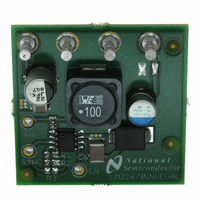LM22670INVEVAL National Semiconductor, LM22670INVEVAL Datasheet

LM22670INVEVAL
Specifications of LM22670INVEVAL
Related parts for LM22670INVEVAL
LM22670INVEVAL Summary of contents
Page 1
... Input Range 35V, 12V nominal Output Voltage: -5V Output Current Range 1.5A Frequency of Operation: 500 kHz Board Size: 1.5 X 1.65 inches Package: PSOP-8 © 2009 National Semiconductor Corporation National Semiconductor Application Note 1888 Frederik Dostal July 9, 2009 Evaluation Board Startup Before applying power to the LM22670 polarity-inverting eval- uation board, all external connections should be verified ...
Page 2
FIGURE 1. Evaluation Board Schematic Inverting Topology Design Considerations Figure 1 shows the typical configuration of a polarity-inverting converter using the LM22670 switching regulator. This invert- ing topology design can be implemented with any member of the LM2267X SIMPLE SWITCHER ...
Page 3
Inductor Selection Duty-cycle is calculated as: where V is the D1 diode voltage drop and V D drop across the LM22670 internal power N-FET. The R of the FET is specified in the LM22670 datasheet to cal- (ON) culate V ...
Page 4
Input Capacitor Selection The input capacitor needs to be selected based on its low ESR value and the high RMS current rating capable of sup- porting high current changes on the input of the application. Low ESR bypass capacitors located ...
Page 5
... To in- crease the phase margin for applications using low input voltages, select a higher capacitance value for C6 and C7. It TABLE 1. LM22670INVEVAL Bill of Materials for VOUT = -5V, Designed for 1.5A Output Current Ref # C1, C8 2.2 µF 50V ceramic C2 22 µ ...
Page 6
Performance Characteristics Unless otherwise specified 12V FIGURE 5. Start-Up Waveforms (Load Resistor = 4Ω) FIGURE 6. Efficiency vs I www.national.com = 25° -5V. A OUT 30075219 FIGURE 7. Overall Loop Gain and Phase 30075217 ...
Page 7
PCB Layout Diagram 7 30075213 www.national.com ...
Page 8
... FIGURE 8. LM22670INVEVAL PCB Layout 8 30075214 ...
Page 9
9 www.national.com ...
Page 10
... For more National Semiconductor product information and proven design tools, visit the following Web sites at: Products Amplifiers www.national.com/amplifiers Audio www.national.com/audio Clock and Timing www.national.com/timing Data Converters www.national.com/adc Interface www.national.com/interface LVDS www.national.com/lvds Power Management www.national.com/power Switching Regulators www.national.com/switchers LDOs www.national.com/ldo LED Lighting www ...









